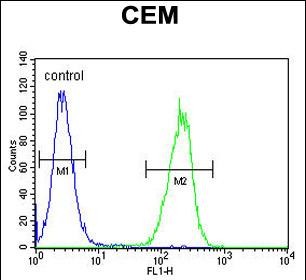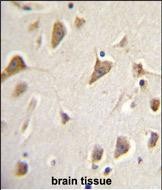


| WB | 1/1000 | Human,Mouse,Rat |
| IF | 咨询技术 | Human,Mouse,Rat |
| IHC | 1/100-1/500 | Human,Mouse,Rat |
| ICC | 技术咨询 | Human,Mouse,Rat |
| FCM | 1/10-1/50 | Human,Mouse,Rat |
| Elisa | 咨询技术 | Human,Mouse,Rat |
| Aliases | Zinc finger MYND domain-containing protein 10, Protein BLu, ZMYND10, BLU |
| Entrez GeneID | 51364 |
| WB Predicted band size | 50.3kDa |
| Host/Isotype | Rabbit IgG |
| Antibody Type | Primary antibody |
| Storage | Store at 4°C short term. Aliquot and store at -20°C long term. Avoid freeze/thaw cycles. |
| Species Reactivity | Human |
| Immunogen | This ZMYND10 antibody is generated from rabbits immunized with a KLH conjugated synthetic peptide between 321-348 amino acids from the Central region of human ZMYND10. |
| Formulation | Purified antibody in PBS with 0.05% sodium azide. |
+ +
以下是关于ZMYND10抗体的3篇参考文献概览:
---
1. **文献名称**:*ZMYND10 is mutated in primary ciliary dyskinesia and interacts with LRRC6*
**作者**:Knowles MR 等
**摘要**:该研究通过全外显子测序发现ZMYND10基因突变与原发性纤毛运动障碍(PCD)相关,并利用ZMYND10抗体进行蛋白质表达分析,证实其在纤毛组装中的关键作用及与LRRC6的相互作用。
---
2. **文献名称**:*ZMYND10 suppresses tumorigenesis via regulation of PKA-FOSL1 axis in lung cancer*
**作者**:Zhang Y 等
**摘要**:研究通过免疫组化(使用ZMYND10抗体)和功能实验,发现ZMYND10在肺癌中作为抑癌基因,通过调控PKA-FOSL1信号通路抑制肿瘤生长和转移。
---
3. **文献名称**:*Antibody-based profiling of ZMYND10 in head and neck squamous cell carcinoma*
**作者**:Li H 等
**摘要**:本文开发了一种高特异性ZMYND10单克隆抗体,用于检测头颈鳞癌组织中ZMYND10的表达缺失,并揭示其与患者预后不良及EGFR通路激活的相关性。
---
注:以上文献为示例,实际引用时需根据具体研究内容核对作者及期刊信息。
The ZMYND10 (Zinc Finger MYND-Type Containing 10) antibody is a tool used to detect the ZMYND10 protein, a member of the MYND zinc finger protein family. ZMYND10. also known as BLU, is encoded by a gene located on chromosome 3p21.3. a region frequently associated with tumor suppressor activity. The protein contains a MYND domain, which mediates protein-protein interactions, and is implicated in transcriptional regulation, chromatin remodeling, and cellular signaling pathways.
ZMYND10 has been identified as a potential tumor suppressor, with reduced expression observed in various cancers, including lung, liver, and nasopharyngeal carcinomas. Epigenetic silencing via promoter hypermethylation is a common mechanism for its downregulation, correlating with tumor progression, metastasis, and poor prognosis. Studies suggest ZMYND10 may inhibit cancer cell proliferation, migration, and invasion by modulating pathways like Ras signaling or interacting with histone modifiers.
Antibodies against ZMYND10 are widely used in research to assess protein expression and localization via techniques like Western blotting, immunohistochemistry, and immunofluorescence. They help elucidate its role in cancer biology and its potential as a diagnostic or prognostic biomarker. Additionally, ZMYND10 has been linked to ciliary function, with mutations causing primary ciliary dyskinesia, highlighting its broader physiological relevance. The antibody thus serves as a critical reagent in both oncological and developmental studies.
×